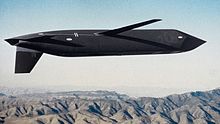This article needs additional citations for verification. (January 2008) |
| AGM-129 Advanced Cruise Missile | |
|---|---|
 | |
| Type | Air-launched cruise missile |
| Place of origin | United States |
| Service history | |
| In service | June 1990 – April 2012 |
| Used by | U.S. Air Force (decommissioned) |
| Production history | |
| Manufacturer | General Dynamics (initially) Raytheon |
| Produced | July 1985 |
| Specifications | |
| Mass | more than 3,700 lb (1,680 kg) |
| Length | 20 ft 10 in (6.35 m) |
| Diameter | 2 ft 5 in (705 mm) |
| Wingspan | 10 ft 2 in (3.1 m) |
| Warhead | W80-1 nuclear warhead |
| Engine | Williams International F112-WR-100 turbofan 2.67–3.25 kN (600–730 lbf) |
Operational range | 1,865–2,000 nautical miles (3,450–3,700 km) |
| Maximum speed | 500 mph (800 km/h) |
Guidance system | Inertial guidance system enhanced with Lidar and Terrain Contour Matching (TERCOM). |
Launch platform | B-52 Stratofortress |
The AGM-129 ACM (Advanced Cruise Missile) was a low-observable, subsonic, turbofan-powered, air-launched cruise missile originally designed and built by General Dynamics and eventually acquired by Raytheon Missile Systems. Prior to its withdrawal from service in 2012, the AGM-129A was carried exclusively by the US Air Force's B-52H Stratofortress bombers.